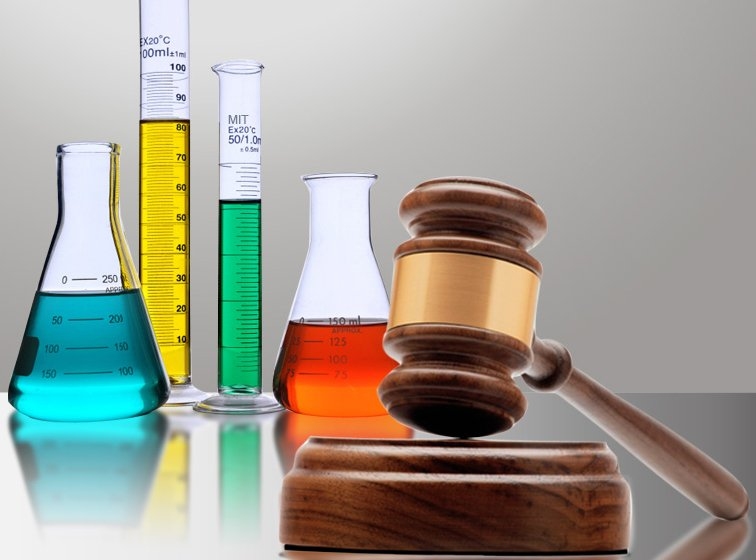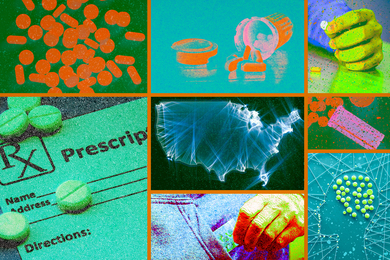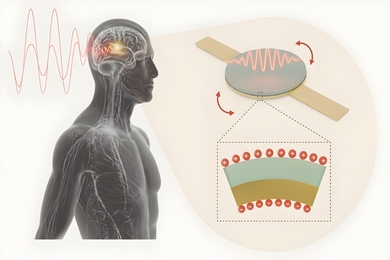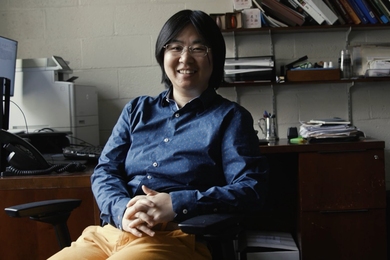Last week, tucked away in a second-floor teaching space at the MIT Museum known as “the cell,” students huddled together in a dark corner of the room labeled “nucleus,” where they laboriously snapped together LEGOs — in this case representing nucleotides — to match a long chain of genetic material in front of them.
Then, clutching their strands of messenger RNA, they were ushered toward the center of the room by their instructor, Kathy Vandiver, who sat them at small tables marked “ribosome” and set them off building proteins out of additional toy bricks.
But these weren’t primary school students. They were judges from all over the country who had come to MIT for Judges’ Science School, a crash course in scientific information and methods for legal professionals.
Sponsored by the Advanced Science and Technology Adjudication Resource Center (ASTAR), a professional organization funded by the U.S. Department of Justice, Judges’ Science School convenes six to eight workshops each year with participants selected by chief justices in 47 U.S. jurisdictions. This session, the first ever held at MIT, was on “Gene-Environment Interaction in Health and Disease.”
That’s where the LEGO came in. “We wanted to make the session very hands-on,” says Vandiver, the outreach director for MIT’s Center for Environmental Health Sciences (CEHS), which hosted the event along with the MIT Museum and the Broad Institute. The activity was intended to help judges visualize DNA’s structure and function, so they could better understand how mutations in the molecule lead to cancer and other diseases.
The theme is a timely one. Scientists are increasingly answering the decades-old question of “nature versus nurture” — that is, whether our health and behavior are determined by our genes or our surroundings — with a resounding “both.” New discoveries show that the risk of everything from criminal activity to skin cancer is mediated by the complex interplay between a person’s environment and his or her genetic predispositions.
But this interaction makes it difficult to establish true causation, something that’s critical in the courtroom. “If I experience adverse radiation exposure at a certain site and I develop cancer, whose fault is that? Is anyone to blame? Who pays?” asks Franklin Zweig, a senior fellow at ASTAR and director of the event.
The ‘X’ factor
The consensus among the CEHS presenters — Leona Samson, the Uncas (1923) and Helen Whitaker Professor of Toxicology and Biological Engineering and CEHS director; and Bevin Engelward, an associate professor of biological engineering — was that for any given individual, those questions are very difficult to answer. Radiation and other environmental toxins cause mutations in DNA, which are known to lead to cancer — sometimes. But mutations can be caused by a number of other factors we wouldn’t ordinarily consider toxic, and they also occur spontaneously over the natural lifetime of a cell. On top of that, some individuals are genetically blessed with an increased capacity to repair their DNA, meaning that two people exposed to the same quantity of radiation over the same period of time may be at different risks of developing cancer.
Over the three-day workshop, the judges gained an appreciation for this tangled web of cause and effect. “It’s obviously very difficult to say with any degree of certainty that factor ‘X’ was the causative one — that without it, the disease wouldn’t have happened,” says Paul Kapalko, a civil court judge in New Jersey.
Of course, judges aren’t left to make those calls entirely on their own; most cases that hinge on scientific or medical evidence invoke the testimony of expert witnesses. But just who qualifies as an expert? Judges need a basic knowledge of science so they can sniff out testimony that seems based on flawed research, or out of line with what’s generally accepted by the scientific community. Kapalko describes this role as the “gatekeeper” of information in the courtroom.
“All we can do is help ensure that something that’s not truly science doesn’t get in front of the jury,” he says. “Our job here is to understand the science better so we can perform that duty.”
Getting things right
To that end, much of the event was devoted to giving judges tools to evaluate scientists’ methods and conclusions. Participants toured labs at the Broad Institute and heard from researchers about how they analyze and interpret data. They got a chance to learn firsthand how scientists correlate genetic mutations with specific diseases by donning gloves and pipetting samples of DNA into gel for separation in the teaching lab of Megan Rokop, the Broad’s outreach director. Jane Beckering, a judge on the Michigan Court of Appeals, called the program “absolutely fabulous.”
“Science is developing at an incredible rate, and we need to do our best to keep up. This is the kind of evidence we’re going to see in years to come,” she says, adding that she’d had two recent cases — one involving toxic mold, the other an overdose of radiation in a cancer patient — in which she felt she would have benefited from a better understanding of genetics and environmental health factors.
Zweig says the best way for judges to stay current is through direct interaction with scientists themselves, who appreciate both the complexity of the work and what’s at stake in applying it to real-world cases.
“The justice system depends on the ability of the court to get things right, and the ability to get things right depends on objective, even-handed information,” Zweig said. “So we go to places that have [that information] and can dispense it.”
For their part, the MIT and Broad researchers were eager to do just that. “At CEHS, [an event like this] is part of our will and obligation,” Samson says. Engelward adds that she was impressed with the judges’ receptiveness and the quality of their questions. She says she also appreciates how this type of training can benefit society as a whole: “As judges, they have such influence, so this was an efficient way to touch a much larger population.”
Timothy Henderson, a district judge in Wichita, Kan., echoes that sentiment. There were 32 judges at the MIT session of Science School — very few, considering that 28 million cases were filed in the U.S. legal system last year alone. But Henderson says the participants will share their new scientific knowledge with their colleagues. “We don't live in an ivory tower in the courtroom,” he says, adding that he has regular interaction with other judges, legislators and lawyers through his state bar and his service on various committees.
Building on a concept he’d learned earlier that day — through LEGOs — Henderson offers a metaphor: “Maybe we are the mutation within the judicial community.”
Then, clutching their strands of messenger RNA, they were ushered toward the center of the room by their instructor, Kathy Vandiver, who sat them at small tables marked “ribosome” and set them off building proteins out of additional toy bricks.
But these weren’t primary school students. They were judges from all over the country who had come to MIT for Judges’ Science School, a crash course in scientific information and methods for legal professionals.
Sponsored by the Advanced Science and Technology Adjudication Resource Center (ASTAR), a professional organization funded by the U.S. Department of Justice, Judges’ Science School convenes six to eight workshops each year with participants selected by chief justices in 47 U.S. jurisdictions. This session, the first ever held at MIT, was on “Gene-Environment Interaction in Health and Disease.”
That’s where the LEGO came in. “We wanted to make the session very hands-on,” says Vandiver, the outreach director for MIT’s Center for Environmental Health Sciences (CEHS), which hosted the event along with the MIT Museum and the Broad Institute. The activity was intended to help judges visualize DNA’s structure and function, so they could better understand how mutations in the molecule lead to cancer and other diseases.
The theme is a timely one. Scientists are increasingly answering the decades-old question of “nature versus nurture” — that is, whether our health and behavior are determined by our genes or our surroundings — with a resounding “both.” New discoveries show that the risk of everything from criminal activity to skin cancer is mediated by the complex interplay between a person’s environment and his or her genetic predispositions.
But this interaction makes it difficult to establish true causation, something that’s critical in the courtroom. “If I experience adverse radiation exposure at a certain site and I develop cancer, whose fault is that? Is anyone to blame? Who pays?” asks Franklin Zweig, a senior fellow at ASTAR and director of the event.
The ‘X’ factor
The consensus among the CEHS presenters — Leona Samson, the Uncas (1923) and Helen Whitaker Professor of Toxicology and Biological Engineering and CEHS director; and Bevin Engelward, an associate professor of biological engineering — was that for any given individual, those questions are very difficult to answer. Radiation and other environmental toxins cause mutations in DNA, which are known to lead to cancer — sometimes. But mutations can be caused by a number of other factors we wouldn’t ordinarily consider toxic, and they also occur spontaneously over the natural lifetime of a cell. On top of that, some individuals are genetically blessed with an increased capacity to repair their DNA, meaning that two people exposed to the same quantity of radiation over the same period of time may be at different risks of developing cancer.
Over the three-day workshop, the judges gained an appreciation for this tangled web of cause and effect. “It’s obviously very difficult to say with any degree of certainty that factor ‘X’ was the causative one — that without it, the disease wouldn’t have happened,” says Paul Kapalko, a civil court judge in New Jersey.
Of course, judges aren’t left to make those calls entirely on their own; most cases that hinge on scientific or medical evidence invoke the testimony of expert witnesses. But just who qualifies as an expert? Judges need a basic knowledge of science so they can sniff out testimony that seems based on flawed research, or out of line with what’s generally accepted by the scientific community. Kapalko describes this role as the “gatekeeper” of information in the courtroom.
“All we can do is help ensure that something that’s not truly science doesn’t get in front of the jury,” he says. “Our job here is to understand the science better so we can perform that duty.”
Getting things right
To that end, much of the event was devoted to giving judges tools to evaluate scientists’ methods and conclusions. Participants toured labs at the Broad Institute and heard from researchers about how they analyze and interpret data. They got a chance to learn firsthand how scientists correlate genetic mutations with specific diseases by donning gloves and pipetting samples of DNA into gel for separation in the teaching lab of Megan Rokop, the Broad’s outreach director. Jane Beckering, a judge on the Michigan Court of Appeals, called the program “absolutely fabulous.”
“Science is developing at an incredible rate, and we need to do our best to keep up. This is the kind of evidence we’re going to see in years to come,” she says, adding that she’d had two recent cases — one involving toxic mold, the other an overdose of radiation in a cancer patient — in which she felt she would have benefited from a better understanding of genetics and environmental health factors.
Zweig says the best way for judges to stay current is through direct interaction with scientists themselves, who appreciate both the complexity of the work and what’s at stake in applying it to real-world cases.
“The justice system depends on the ability of the court to get things right, and the ability to get things right depends on objective, even-handed information,” Zweig said. “So we go to places that have [that information] and can dispense it.”
For their part, the MIT and Broad researchers were eager to do just that. “At CEHS, [an event like this] is part of our will and obligation,” Samson says. Engelward adds that she was impressed with the judges’ receptiveness and the quality of their questions. She says she also appreciates how this type of training can benefit society as a whole: “As judges, they have such influence, so this was an efficient way to touch a much larger population.”
Timothy Henderson, a district judge in Wichita, Kan., echoes that sentiment. There were 32 judges at the MIT session of Science School — very few, considering that 28 million cases were filed in the U.S. legal system last year alone. But Henderson says the participants will share their new scientific knowledge with their colleagues. “We don't live in an ivory tower in the courtroom,” he says, adding that he has regular interaction with other judges, legislators and lawyers through his state bar and his service on various committees.
Building on a concept he’d learned earlier that day — through LEGOs — Henderson offers a metaphor: “Maybe we are the mutation within the judicial community.”






